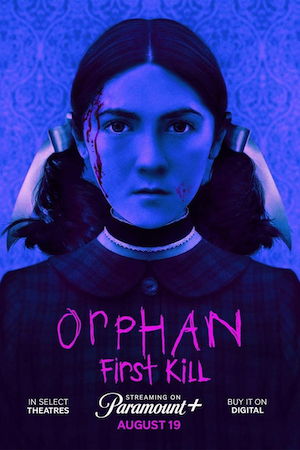 ORPHAN: FIRST KILL is a good version of a usually under-appreciated popular art form: the knowingly-trashy-but-not-too-winky-about-it horror-thriller. I’m surprised and happy to see it getting as much love as it is, and hopefully that’s not setting expectations too high. I think it could kinda be like a 21st century version of the STEPFATHER trilogy. Though both started with the loose inspiration of real life crimes, the ORPHAN premise has the advantage of seeming much more absurd from the beginning, and therefore more ripe for escalation. I haven’t seen anyone arguing that it’s exploitative (in a bad way) to continue the adventures of Esther nee Leena (Isabelle Furhman, THE HUNGER GAMES), the (spoiler for ORPHAN part 1) dangerous escaped mental patient who pretends to be an innocent little girl.
ORPHAN: FIRST KILL is a good version of a usually under-appreciated popular art form: the knowingly-trashy-but-not-too-winky-about-it horror-thriller. I’m surprised and happy to see it getting as much love as it is, and hopefully that’s not setting expectations too high. I think it could kinda be like a 21st century version of the STEPFATHER trilogy. Though both started with the loose inspiration of real life crimes, the ORPHAN premise has the advantage of seeming much more absurd from the beginning, and therefore more ripe for escalation. I haven’t seen anyone arguing that it’s exploitative (in a bad way) to continue the adventures of Esther nee Leena (Isabelle Furhman, THE HUNGER GAMES), the (spoiler for ORPHAN part 1) dangerous escaped mental patient who pretends to be an innocent little girl.
I probly didn’t need that spoiler warning. By now anybody who knows what ORPHAN is knows that wild plot twist: the adopted little girl who’s been terrorizing Vera Farmiga and making everybody think she’s crazy and abusive turns out to be a woman in her 30s with a rare hormonal disorder and a false identity. What makes this prequel so unlikely and so delightfully audacious is that Fuhrman originally played the character when she was around 12, and instead of recasting they brought her back at the age of 24, using Hobbitvision (forced perspective and body doubles) to make her look small. I honestly found it easy to forget, but just knowing they went through the trouble for this movie gives it an extra kick.
 It’s a prequel because Esther died in part 1, though I’m optimistic they’ll find some way around that in a future installment, if needed. Here we find Esther under her maybe-real name Leena Klammer, already the most feared patient at a remote Estonian psychiatric ward called the Saarne Institute. There’s an implication that she’s already lived some unseen ORPHAN prequel impersonating a young runaway, so maybe this will turn into a chronologically backwards trilogy.
It’s a prequel because Esther died in part 1, though I’m optimistic they’ll find some way around that in a future installment, if needed. Here we find Esther under her maybe-real name Leena Klammer, already the most feared patient at a remote Estonian psychiatric ward called the Saarne Institute. There’s an implication that she’s already lived some unseen ORPHAN prequel impersonating a young runaway, so maybe this will turn into a chronologically backwards trilogy.
Despite her size disadvantage against other cinematic killers in the non-doll, non-leprechaun division, li’l Leena mounts a respectable escape and launches a fun new Orphan adventure by going through age progressions of missing children and pretending to be the one that most resembles her. She claims to have been kidnapped and brought to Russia for four years (thus her accent) and before she knows it she’s living under the name Esther with the well-to-do Albright family in Darien, Connecticut, U.S.A.
Julia Stiles (EDMOND) ostensibly fills the Vera Farmiga role of earnest mother trying to love Esther but noticing something’s not right. Esther fucks up a little bit on her con (feigning excitement to see her grandma, who’s long dead) and then goes into the bathroom to throw a tantrum about it.
This is one way the prequel plays a little different – since they don’t have to preserve Esther’s secret, they can give us a little more of the procedure of trying to pull it off. And it allows for the movie’s most memorably cinematic moment: Esther driving and enjoying a cigarette while listening to Michael Sembello’s “Maniac,” the anthem from FLASHDANCE that was partly inspired (before being rewritten) by William Lustig’s MANIAC.
Tricia’s husband Allen (Rossif Sutherland, POSSESSOR) seems to have been completely broken by the disappearance of his daughter. He’s a famous painter but became withdrawn and stopped working. The real Esther had no interest in art, but this new one is very talented at drawing, and they start spending time making art together in his studio.
In the first film Esther’s oldest sibling was 12 – this time she gets a teenage brother named Gunnar (Matthew Finlan), a rich boy doofus who enjoys fencing and has asshole friends who think it’s okay to make bullying comments to a little girl they believe has just returned from 4 years of torment in Russia! What the fuck, teens? I don’t have many complaints about this movie but those fuckos definitely could and should have met some elaborate SLEEPAWAY CAMP sequel type deaths.
At first FIRST KILL seems to earnestly explore the domestic thriller drama we expect – the family trying to adjust to their strangely different daughter, trying to give her space to feel comfortable. We can see that a rift has formed in the marriage since the loss of their daughter, and how her supposed return brings them back together. Esther makes mistakes that cause mom, brother, a child psychiatrist (Samantha Walkes, Murdoch Mysteries) and a detective (Hiro Kanagawa, THE HUNTED, CRYING FREEMAN, TURBULENCE 2, JOSIE AND THE PUSSYCATS, ELEKTRA) to seem suspicious, so she has to figure out ways to convince them or, sometimes, kill somebody.
Director William Brent Bell (THE BOY) and screenwriter David Coggeshall (Scream: The TV Series), with a story credited to original writers David Leslie Johnson-McGoldrick & Alex Mace, do a respectably disreputable job of making things tawdry and uncomfortable. There’s an implication (like in the first one) that Esther is trying to make the moves on the guy who thinks he’s her dad, which is squirmy enough. But I think the grossest part is in the mental hospital when she pulls the ol’ “maybe I can make it worth your while” seduction move to get a guard’s guard down. It’s this well worn cliche about the sexual power of a predatory female and/or the weakness of males to said power, but with extra complication: the guard knows Esther is an adult, but his attraction to her has to be pedophilic, right? Since the scene requires our understanding that the actress is an adult to be at all stomach-able, there’s a sense of mischievous provocation we don’t see in that much studio product these days.
On a lighter note, I want to mention that there’s a small subplot about Esther befriending a rat that lives in her wall. I don’t know why, but I like when movie characters do that. Most movies could be improved by adding a rat friendship.
Cinematographer Karim Hussain is the guy who did HOBO WITH A SHOTGUN and POSSESSOR. There are a few little splashes of style, with a particular interest in strobe lights. They’re used effectively in the Saarne Institute suspense sequence, and there’s a gimmick that Allen’s paintings reveal different images under blacklight, so he’s constantly flipping between the two in his studio. I was mildly disappointed Esther didn’t use it to hide something really nasty in the paintings, but that’s because I forgot she actually did that in the first movie. Actually it’s kinda better not remembering that. It works on the level of 1) being a metaphor for Esther’s deception and 2) looking cool.
As has been widely reported, the filmatists wisely found a new outlandish twist to keep things fresh. It upends the proceedings in a funny way and messes with our sympathies. We get enough good vs. evil in our movies – this reminds us that sometimes watching a bunch of assholes battle to out-asshole each other is what we need. Reading over what I wrote about ORPHAN thirteen years ago (!) I realize there’s a depth to the protagonist and themes of the original that I don’t really see here, but that’s okay. I think it’s legitimate to lean harder into the Lifetime Movie From Hell sort of feel, and I hope there’s at least one more and that it takes a full on Evil Knievel style jump over the fabled Top.
Everyone involved – director, writers, cast – deserve praise for pitching this one to just the right spot. It’s especially fun to see the often-underutilized Stiles in a role that gives her a bunch to play with, but of course the crucial decision was in keeping Fuhrman (who at first was only going to cameo, but ended up star, associate producer and uncredited rewriter). In the first one she gives a good child actor evil-kid performance, but an adult playing an adult playing a child, and modulating the correct balance between straightness and camp, is an entirely different feat.
I had a rare experience with the first ORPHAN: having no interest in what seemed like a standard evil child movie, I let somebody tell me the twist. That made it sound so good I went and paid to see it in a theater, and had a great time, calling it “a surprisingly smart and enjoyable evil-child suspense thriller.” The movie was a sizable hit, but I don’t remember it getting alot of mainstream respect outside of Roger Ebert (42 on Metacritic, D+ in Entertainment Weekly, called a “depraved, worthless piece of filth” by Ann Hornaday in the Washington Post, etc.) Over time it has gained some cult appeal, but this belated prequel still seems so incredibly unlikely that I have to be grateful for its existence. I had planned to see it in a theater, but since I found myself isolating with Covid I took advantage of the weird Paramount+ day-and-date release and watched it on a laptop in bed. Not usually my preference, but it hit the spot under those circumstances, so thank you weird trashy prequel for being there when I needed you most.


























August 30th, 2022 at 5:08 pm
Welcome back! Hopefully, the streaming wars will open the door to a renaissance of those kind of pulpy movies.